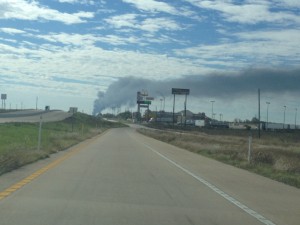Something Wicked This Way Blows…..
 Events like the gas pipeline explosion in Milford are graphic reminders of just how vulnerable our North Texas air shed is to pollution sources from Ellis County. Proximity, predominant wind patterns, and potential for disaster combine to make our Southern neighbor a constant threat.
Events like the gas pipeline explosion in Milford are graphic reminders of just how vulnerable our North Texas air shed is to pollution sources from Ellis County. Proximity, predominant wind patterns, and potential for disaster combine to make our Southern neighbor a constant threat.
On Thursday, one could see the plume of smoke stretch out south to north across the entire Metromess. It's a safe bet that not too many of the 6 million plus residents of greater DFW knew there was a town called Milford near them at the beginning of the day, but a lot of them had inhaled Milford soot by evening.
That would be the same soot that reporters keep reminding us "the EPA" says is "non-toxic," based on measurements. Except there is no such thing as non-toxic smoke from a combustion source, which the Milford explosion and fire most certainly was. All combustion produces soot, or Particulate Matter. According to the latest evidence from research scientists, there is no safe level of exposure to PM Pollution. That is, any amount of PM pollution can do human health damage. Even short-term exposure can lead to asthma attacks, heart attacks and strokes. How do we know this – the EPA tell us so on their own website.
Only a couple of years ago, the Magnablend fire in Waxahachie poured its own plume of "non-toxic" smoke into DFW skies, despite the incineration of a large variety of chemicals used in the oil and gas industry. You might remember the water run-off from fighting that fire went into a creek and killed a lot of fish. But don't worry, that same stuff in your lungs is nothing to worry about. Perfectly natural to be able to see what your breathing.
Perhaps the most spectacular modern reminder of how close Ellis County is to us in air miles came back in 1995 when a Midlothian-based tire dump, called…wait for it…."Safe Tire Disposal Company" that was actually a collection site for the nearby cement plant tire-burning operation caught fire its own self.
There are fires, and then there are tire fires. They burn extremely hot, produce a lot of that "non-toxic" smoke, and can keep going for days. And that's exactly what happened in Midlothian. The predominant southerly winds carried all that dark dense smoke right into Downtown Dallas, where it surrounded and engulfed whole office buildings.
Timing is everything and so it was with the Safe Tire Fire. It happened at the exact moment when local citizens were engaged in very public debate with state and local officials over whether air pollution from the three large cement plants in Midlothian (two of which were burning tires) could impact air quality in DFW. You read that correctly. In 1995, citizens were still trying to make the case that millions of pounds of air pollution released just across the Dallas and Tarrant County lines could possibly have a negative impact on metropolitan smog levels. And it was an uphill fight. Officially, there was no confirmation of the impact of these facilities. The DFW air plan stopped at the County Line. Unofficially, you could see the cement plant smokestacks as you drove I-20 across Grand Prairie and Arlington.
When those tires went up in smoke, so did the arguments being used to downplay the impact of Ellis County pollution. It was like adding a dark black dye to the North Texas air flow, beginning in Midlothian, and watching it be carried downstream/downwind right into the heart of downtown Dallas. It was the most defiant demonstration of the citizen's arguments one could imagine. After that, it was a lot easier for everyone to understand Midlothian was only a breeze away from their lungs.
With yet another fire in Ellis County setting off yet another dark, thick plume of smoke that wafts into DFW, we get a reminder of how much closer together the air brings us. Only about half an hour or so away from Milford, a little bit further south, is a new belt of natural gas compressors churning out voluminous amounts of air pollution that's being blown in the same direction as the smoke from that gas pipeline explosion. Unlike that smoke, pollution from these facilities will keep being released 24/7 for the foreseeable future. Add up all this new compressor pollution and it could rival the impact of a new coal plant – just upwind of us. Just because you can't see it doesn't mean it's not having an impact.
Once again, the state's position is that this pollution is no big deal. Once again, citizens are disagreeing. Who would you put your money on?
